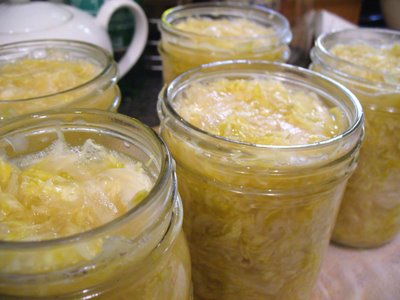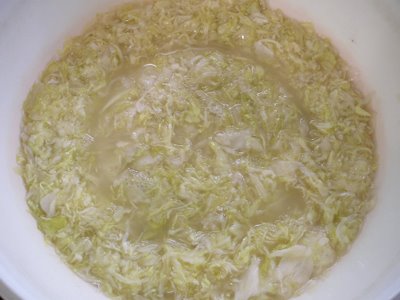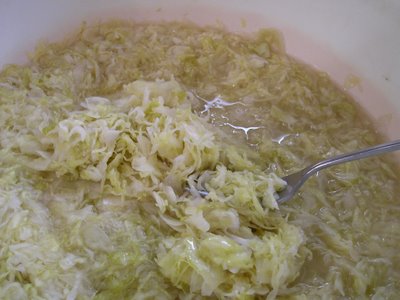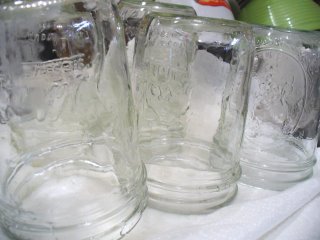Semi(Sentimental) Homemade

It was me, Hazel, and a trailor home full of the smell of cooked sauerkraut.
Hazel worked at a paper mill by day, drove a huge car, carried around a pack of cigarettes in a flashy, old lady cigarette case, smoked like a chimney, and by night practiced Country-Western electric slide guitar in her sewing room.
Oh, and she became the designated babysitter whenever my parents wanted a night to themselves.
I loved the days and nights I could stay with her. She had one of those old, gaudy, gold-painted Rain Lamps that were large, had a half-naked lady in the middle, and had wires that criss-crossed down around her while hot oil streamed at different speeds down to the bottom. It was a hot oil rain that mesmerized me for hours.
She also had a genuine German cuckcoo clock, and I would often stand on the top of her couch to get a better look at it; again, mesmerized for hours.
Out behind her trailer was a well covered up by a few flimsy wooden boards that a small child, like me, could easily fall down and become the nation's top news story for a week. I use to play by running and jumping over it because, even then, I loved the allure of danger.
Near the well was a small trailer full of board games, toys, records and other items that had belonged to her teenage daughter, Tess, who was killed in a car accident one night while out with her friends. Hazel kept the trailer full of Tess's clothes and possessions, since I guess she could never bear to part with them. I don't know – maybe she was waiting for the day Tess would come home, as if the years that had passed were just one long bad dream.
Wanna hear a ghost story?
Well, Mom later told me that one night, when we all were staying over at Hazel's, she was awakened by a presence at the side of the bed. When she opened her eyes, she saw Tess standing beside her, holding her hand.
I think I remember Mom saying that she felt at ease and peaceful, as if Tess was a good spirit, and not that nasty one who keeps crawling out of the well.
On the nights when it was just Hazel and I, we laughed a lot, particularly at the dancing or bad performances on Solid Gold with Marilyn McCoo. In between laughing, I sometimes helped her cook – mostly by stiring the sauerkraut that was heating up on the stovetop.
She got the biggest kick out of my love for sauerkraut. No child she had ever known, and few adults as well, loved sauerkraut, and I think perhaps she might have felt a little bit alone in the world because of it. So, we were instantly buddies.
Whenever I would leave, she always would say something to the effect of, "well, when I see you next I'll have a pot of sauerkraut waiting for you!"
And, you know what?
She did.
So, you see, this food, this stinky cabbage pickle that is reviled by so many (even Bruce hates it), is special to me. When you bite into it on your hot dog or Reuben or have it served with sausages al'Alsacienne, you may just be enjoying a salty, sour condiment or side. But when I bite into it, I think back and remember that person in my life who nurtured me, who loved to see me (and I her), who shared part of her life with me, and whom I will forever have a place in my heart for.
----
What took me so long to make my own sauerkraut from scratch (since I've never felt the urge to buy it canned), is anybody's guess, since it's so easy to prepare.
Most of the books I have on food preservation and pickling basically say the same thing.
Here's what I did:
First, I bought 2 heads of cabbage, whose leaves were unblemished and wrapped tight along the head. Together, they weighed 5 pounds. I left these to sit at room temperature for 24 hours.
Next, I washed, then cored, the cabbages and removed any bruised or wilted leaves. Working in small batches, I shredded the cabbage using the shredding blade on my Cuisinart. As I emptied them into the tupperware container (don't use metal) I would use to ferment them in, I salted the shredded cabbage with Morton's Canning/Pickling Salt, which you can buy at Safeway.

You could also use Kosher salt, but the crystals are much larger and don't distribute through the cabbage as well. You definitely don't want to use regular table or sea salt when pickling or preserving since they have additives or impurities that could hamper or ruin what you're trying to preserve/pickle. Instructions I found for salting the cabbage indicate that 3 tablespoons of salt are necessary for 5 pounds of cabbage. However, I salted as I went, eyeing the salt to cabbage ratio, and I ended up using slightly more than 3 tablespoons.
When fermenting food, such as cabbage, it's important to use just enough salt to prevent unwanted bacteria from forming, but not so much that the good bacteria (the ones that form lactic acid) can't reproduce. Once these good bacteria form and multiply, they create the aforementioned lactic acid, fostering an acidic environment that is hostile to harmful bacteria that can spoil your cabbage and/or make you sick.
Another thing: when fermenting or preserving or making sausages or making cheese: everything must be sterilyzed! Your cutting board, your crock/container, your measuring spoons, your chopping aparatus, etc. Be care of where you sit your knife. Wash your hands everytime you touch something not washed in hot soapy water or submerged in hot water. Paper towels come in handy; use them and not that dish towel that's been used the last 5 times you've washed dishes.
And please don't bleed into anything!
After salting the cabbage, it will begin to release its own liquid. Press down on the cabbage as you go and when you're finished, cover it with a plate (or other suitable device). If, when you press down on the plate, the liquid from the cabbage doesn't quite cover the plate, make a weak brine solution and pour it over just enough to cover.

Find something to weigh it down with. I used a plastic container filled with water to do the trick. Once you've weighed it down, cover it and let it sit somewhere cool where it will remain undisturbed by pesky children, nosey old people, and curious cats (no cat blogging, people).

I placed mine on top of our chest freezer - though not directly on top; I sat it on top of an empty, upside-down box. The ambient temperature of where I placed it is between 68 and 72 degrees Farenheit, which means it's fucking cold in my house all of the time.
Temperature is important when fermenting sauerkraut since the higher the temps, the quicker the fermentation process. The quicker the fermentation process, the likelihood of uninvited bacteria colonizing your sauerkraut and spoiling your batch. It also doesn't develop as tart of a sour flavor to it.
So, like with barbecue, you want to go slow and low. The ideal temperature is between 65 and 70, and at this temperature, it will take around 3 weeks to develop a good flavor.
I should warn you that, as it's fermenting, it smells awful. But don't let that fool you into thinking it's gone bad.
You can tell if it's gone bad if it has turned pink or if other types of mold begins to grow on it. Some white mold may grow on the top of the liquid and, if so, spoon it off with slotted spoon or a wire-mesh strainer. For the most part, that mold is harmless, but remove it anyway. As long as your sauerkraut stays submerged and away from oxygen, it shouldn't go bad.

Again, if it is too soft (it should retain some of it's crunch), slimy, or darker than it was before, it has spoiled. Carefully dispose of it (especially so that an animal can't get to it and get sick) and start over.
After 2 weeks, taste it. If you wish to stop the fermentation then, you can do so. In my experience, 3 weeks was optimal.

Now you have the option of storing it in a root cellar (the old-fashioned way), in the refrigerator, or by canning it.
Since I didn't want it taking up what precious little space I have in the fridge, I decided to can it. A lot of people, especially some health nuts, would prefer the first two options as opposed to the last method of storage, since canning the sauerkraut, while stopping the fermentation process, also kills the beneficial bacteria used to ferment it. This is the same bacteria (Lactobacillus) that's found in yogurt and which has been shown to aid gastrointestinal function.
Frankly, I eat a cup of yogurt a day, and that has to go in the fridge. The sauerkraut is getting canned.
Canning doesn't change the great flavor of sauekraut…much. It does mellow it out just a little, as well as softening it some.
To start, you will need some canning jars and brand-new lids.

I don't have any recommendations as far as jars and lids are concerned, other than using wide-mouth jars if you have them, and I think I end up using a mix of Ball and Kerr, which are generally the only two available anyway.
Once you've sterilyzed your jars and lids in hot, soapy water (and rinsed them of course), bring a large pot of water on the stove up to 125F degrees and hold there. For pint-sized jars, I'm using a 14 quart stock pot. Any kind of food thermometer should work well for indicating the temperature of the water – I used a large candy thermometer.

For now, you only want enough water in the pot to cover the jars half-way. Oh, and by the way, I don't have most of the necessary equipment used to can, so I've had to improvise or do without. But speaking from personal experience, you can can (?) without all of the gadgets and do-dahs.
Next, fill your jars with the sauerkraut, leaving about a ½" to ¼" of headspace near the top. If you're lucky enough to have sauerkraut juice leftover, fill the jars (but don't go over the headspace requirement I just mentioned) and save the rest. Aparently, some people like to drink the juice. You could, I suppose, use it as a starter culture for another batch of sauerkraut, which is probably the wisest use of any leftover liquid.
After you have filled the jars, place the lid on the top and screw down the ring, but don't tighten it. In fact, leave it just a little bit loose. The reason why is because canning seals on the lids by pushing out the air. If you've screw the lids on too tight, air won't escape and you may crack the jars.
Now place the sealed jars into the pot, fill the rest of the pot with hot water so that it covers the tops of the jars by 1", and bring the water to a boil. Where I live (less than 100 feet above sea level), the boiling point is 212F. Once your water has reached boiling point, set your timer for 20 minutes.
After boiling for 20 minutes, lift the jars, one at a time and without tipping, carefully from the water (I used a pair of tongs with a good grip on them). Set them on a cooling rack and let them cool down. As they do, you should hear a popping sound, which is the lid being sucked down due to the vacuum you've created in the jar.
Sometimes the lids don't do this right away, so don't worry if they haven't while they're still warm. However, if after completely cooled down your lids still pop up when you press down in the center of them, they didn't seal.

Not to worry though. You can try again, repeating the same process. Or you can store them in the fridge. If you are successful, you'll have a good supply of sauerkraut until next summer.
Although, I probably won't.
I've already gone through 2 of the 5 jars I made!
Next up: Veggie pickles...ok, ok. I know I said I would get to them this time, but aren't you tired of reading yet??
k.
 Hello and welcome. This food blog is based in San Francisco and I'm Kevin, the guy who writes it.
You may know me from my brief, but violent and cracked out, appearance on COPS. Actually, that wasn't me - he didn't even look like me.
I'm more than happy to entertain you, but please don't be so shy. You can comment below or contact me personally at baconprss at yahoo dot com. Oh, and I like to eat sometimes.
Hello and welcome. This food blog is based in San Francisco and I'm Kevin, the guy who writes it.
You may know me from my brief, but violent and cracked out, appearance on COPS. Actually, that wasn't me - he didn't even look like me.
I'm more than happy to entertain you, but please don't be so shy. You can comment below or contact me personally at baconprss at yahoo dot com. Oh, and I like to eat sometimes.

0 Comments:
Post a Comment
<< Home